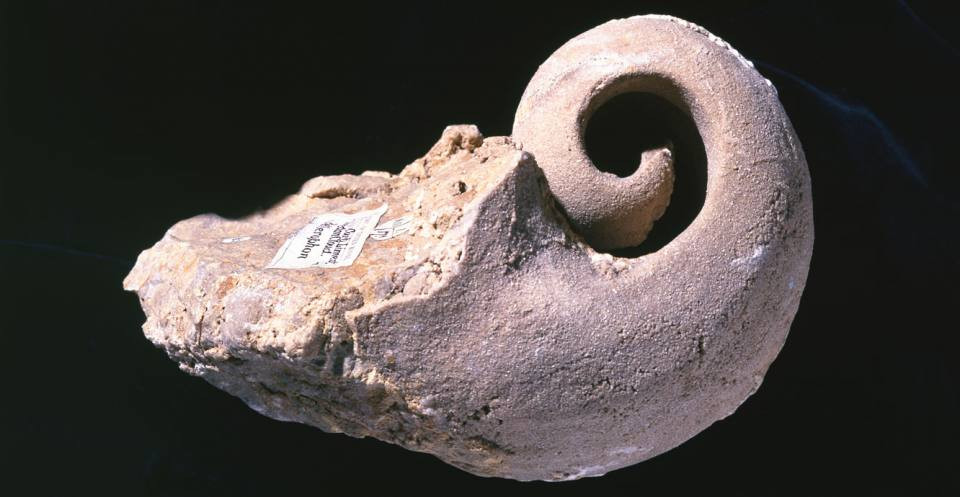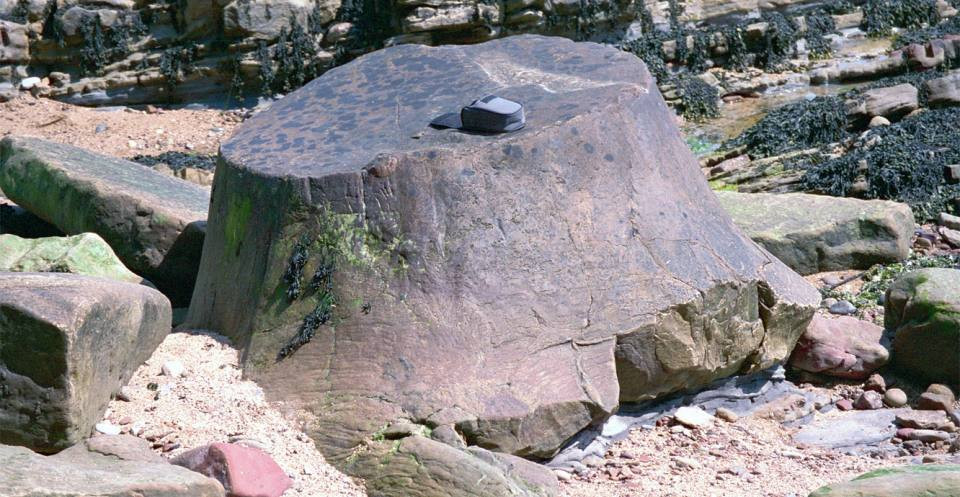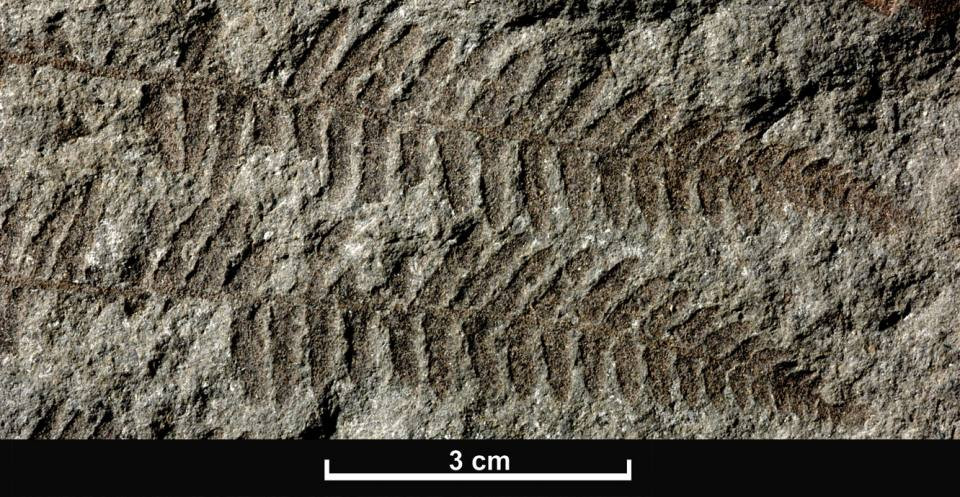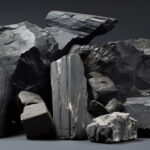What Rock Are Fossils Found In? Fossils are predominantly discovered in sedimentary rocks, as these formations provide the ideal conditions for preservation. At rockscapes.net, we provide a wide array of resources to explore the fascinating world of fossils and the rocks that cradle them, enhancing your landscaping projects with historical depth and natural beauty. Delve into the geology and paleontology that brings these ancient wonders to light, offering unique design elements and inspiring durable, aesthetically pleasing rockscapes.
1. What Rock Types Commonly Contain Fossils?
Fossils are most commonly found in sedimentary rocks due to their formation process. These rocks, such as limestone, sandstone, and shale, are composed of sediments that accumulate over time, often burying organic material.
Elaborating on Sedimentary Rocks
Sedimentary rocks are formed from the accumulation of sediments, which can include minerals, organic matter, and fragments of other rocks. This process often occurs in bodies of water, such as oceans, lakes, and rivers, where sediments settle and compact over millions of years. The gradual burial and compression of these materials create an environment conducive to fossilization.
- Limestone: Often formed from the accumulation of marine organisms like coral and shellfish, limestone is particularly rich in marine fossils.
- Sandstone: Created from compacted sand grains, sandstone can contain fossils of land plants and animals, especially in river and delta environments.
- Shale: A fine-grained rock composed of clay minerals, shale is excellent for preserving detailed impressions of fossils, including delicate plant and insect remains.
Igneous and Metamorphic Rocks: An Exception
While sedimentary rocks are the primary source of fossils, it is rare but possible to find fossils in certain types of fine-grained, low-grade metamorphic rocks. Igneous rocks, formed from cooled magma or lava, typically do not contain fossils because the extreme heat would destroy any organic material. However, metamorphic rocks that have undergone low-grade metamorphism may, in rare cases, contain altered fossils.
2. How Does the Fossilization Process Relate to Rock Formation?
The fossilization process is intimately linked to the formation of sedimentary rocks, with specific conditions required for organic material to be preserved and transformed into fossils.
Stages of Fossilization
- Death and Burial: The process begins when a plant or animal dies and is quickly buried by sediment. Rapid burial protects the remains from scavengers and decomposition.
- Sediment Accumulation: Over time, layers of sediment continue to accumulate, further compressing the organic material.
- Mineralization: As water percolates through the sediment, it carries dissolved minerals that gradually replace the organic material of the remains. This process, known as permineralization, turns the remains into stone.
- Rock Formation: The surrounding sediments become compacted and cemented together, forming sedimentary rock. The fossil is now encased within the rock, preserved for millions of years.
- Erosion and Exposure: Eventually, geological forces and erosion may expose the fossil-bearing rock at the Earth’s surface, where it can be discovered by paleontologists and enthusiasts.
Ideal Environments for Fossilization
Marine environments, such as shallow seas and lagoons, are particularly conducive to fossilization due to the abundance of sediment and the presence of mineral-rich water. Other favorable environments include river deltas, lakes, and swamps, where rapid burial and sediment accumulation are common.
3. What Types of Fossils Are Commonly Found in Sedimentary Rocks?
Sedimentary rocks host a diverse array of fossils, ranging from microscopic organisms to large vertebrates. The type of fossil found depends on the environment in which the rock was formed.
Common Fossil Types
- Marine Fossils: These include the remains of marine organisms such as shellfish, corals, fish, and marine reptiles. Common examples include ammonites, trilobites, and fossilized seashells.
- Plant Fossils: Found in sedimentary rocks formed in terrestrial environments, plant fossils include impressions of leaves, stems, and roots. Coal, a type of sedimentary rock, is formed from the accumulation of plant material over millions of years.
- Vertebrate Fossils: The bones and teeth of vertebrates, such as dinosaurs, mammals, and birds, can be preserved in sedimentary rocks. These fossils provide valuable insights into the evolution and ancient ecosystems.
- Trace Fossils: These are not the remains of the organisms themselves but rather evidence of their activity. Trace fossils include footprints, burrows, and fossilized dung (coprolites).
Specific Examples
- Ammonites: These extinct marine cephalopods are commonly found in limestone and shale. Their distinctive spiral shells make them excellent index fossils for dating rocks.
- Trilobites: These ancient arthropods are found in sedimentary rocks from the Cambrian period. Their segmented bodies and hard exoskeletons are often well-preserved.
- Dinosaur Bones: The fossilized bones of dinosaurs are primarily found in sedimentary rocks, such as sandstone and shale, in areas that were once ancient floodplains or riverbeds.
- Fossilized Coral: Coral fossils are abundant in limestone, providing evidence of ancient coral reefs and marine ecosystems.
4. Where Are Some Famous Fossil Sites Located?
Fossil sites are located around the world, each offering unique insights into the history of life on Earth. These sites often feature sedimentary rock formations that have yielded significant fossil discoveries.
Notable Fossil Sites
- Dinosaur National Monument, USA: Located in Utah and Colorado, this site is famous for its extensive collection of dinosaur fossils preserved in sandstone formations.
- Burgess Shale, Canada: This site in British Columbia is renowned for its exceptional preservation of soft-bodied marine organisms from the Cambrian period. The fossils provide a unique window into the early evolution of animals.
- Messel Pit, Germany: A former oil shale quarry, the Messel Pit is known for its well-preserved fossils of mammals, birds, reptiles, and insects from the Eocene epoch.
- Yixian Formation, China: This geological formation is famous for its feathered dinosaur fossils, providing crucial evidence for the link between dinosaurs and birds.
- Agate Fossil Beds National Monument, USA: Located in Nebraska, this site contains well-preserved mammal fossils from the Miocene epoch, including ancient rhinoceroses and horses.
- Riversleigh Fossil Site, Australia: The site is famous for its collection of fossils, with a wide variety of well-preserved marsupials, birds, and reptiles.
Why These Sites Are Important
These fossil sites are important because they provide a wealth of information about past life on Earth. The fossils found at these sites help scientists understand the evolution of organisms, the changes in Earth’s climate and environment over time, and the relationships between different species.
5. How Do Geologists Use Fossils to Date Rocks?
Geologists use fossils as a crucial tool for dating rocks and understanding the relative ages of different rock layers. This process, known as biostratigraphy, relies on the principle that different fossils are found in rocks of different ages.
Index Fossils
Index fossils are particularly useful for dating rocks. These fossils are:
- Widespread: Found in many different locations around the world.
- Abundant: Common in the rock record.
- Short-Lived: Existed for a relatively short period of geological time.
- Easily Identifiable: Have distinctive features that make them easy to recognize.
By identifying index fossils in a rock layer, geologists can determine the age of the rock with a high degree of accuracy.
Relative Dating
Fossils also help geologists determine the relative ages of rock layers. By examining the sequence of rock layers and the fossils they contain, geologists can determine which layers are older and which are younger. This principle, known as the law of superposition, states that in undisturbed rock sequences, the oldest layers are at the bottom, and the youngest layers are at the top.
Absolute Dating
While fossils provide a means of relative dating, absolute dating methods, such as radiometric dating, are used to determine the actual age of rocks in years. Radiometric dating involves measuring the decay of radioactive isotopes in minerals within the rock. By combining fossil evidence with radiometric dating, geologists can create a comprehensive timeline of Earth’s history.
6. What Role Do Sedimentary Rocks Play in Preserving Trace Fossils?
Trace fossils, which are evidence of an organism’s activity rather than the organism itself, are commonly preserved in sedimentary rocks. These fossils provide valuable insights into the behavior and ecology of ancient organisms.
Types of Trace Fossils
- Footprints: Preserved impressions of animal tracks, providing information about their size, gait, and behavior.
- Burrows: Tunnels or holes dug by animals in sediment, indicating their feeding and dwelling habits.
- Coprolites: Fossilized dung, providing clues about the diet and digestive systems of ancient animals.
- Borings: Holes drilled into rocks or shells by marine organisms, indicating their feeding strategies.
- Root Traces: Impressions of plant roots, providing information about ancient vegetation and soil conditions.
Preservation Process
Trace fossils are preserved in sedimentary rocks through a variety of processes, including:
- Infilling: Sediment fills the footprint or burrow, creating a cast of the original structure.
- Compaction: The weight of overlying sediment compresses the trace, preserving its shape.
- Mineralization: Minerals precipitate within the trace, strengthening and preserving it.
Importance of Trace Fossils
Trace fossils are important because they provide direct evidence of the behavior and ecology of ancient organisms. Unlike body fossils, which only provide information about the organism’s physical characteristics, trace fossils reveal how organisms interacted with their environment.
7. How Does the Environment of Deposition Affect Fossil Preservation?
The environment in which sediments are deposited plays a crucial role in determining whether fossils are preserved and the type of fossils that are found.
Marine Environments
Marine environments are generally the most favorable for fossil preservation due to the abundance of sediment and the presence of mineral-rich water. Shallow seas, lagoons, and coral reefs are particularly conducive to fossilization, as they provide a stable environment for sediment accumulation and the preservation of marine organisms.
Terrestrial Environments
Terrestrial environments, such as river floodplains, lakes, and swamps, can also preserve fossils, although the conditions may be less consistent than in marine environments. Rapid burial by sediment is essential for fossil preservation in terrestrial environments, as it protects the remains from scavengers and decomposition.
Unfavorable Environments
Some environments are not conducive to fossil preservation. These include:
- Rocky mountaintops: Carcasses decay quickly, and there is little sediment deposition.
- Acidic soils: Acidic conditions dissolve bones and shells, preventing fossilization.
- High-energy environments: Strong currents and waves erode and destroy organic material.
8. What Is the Role of Paleontology in Understanding Rock Formations?
Paleontology, the study of fossils, plays a crucial role in understanding rock formations and the geological history of Earth.
Dating Rock Layers
Paleontologists use fossils to date rock layers and correlate rock formations in different locations. By identifying index fossils in a rock layer, paleontologists can determine the age of the rock and compare it to other rock layers around the world.
Reconstructing Ancient Environments
Fossils provide valuable clues about the environment in which the rock was formed. By studying the types of fossils found in a rock, paleontologists can reconstruct the ancient climate, vegetation, and animal life of the area.
Understanding Evolution
Fossils provide direct evidence of the evolution of life on Earth. By studying the fossil record, paleontologists can trace the ancestry of modern organisms and understand how they have changed over time.
Examples
- The discovery of marine fossils in a rock formation indicates that the area was once covered by an ocean.
- The presence of plant fossils in a rock suggests that the area was once a forest or grassland.
- The discovery of dinosaur bones in a rock formation provides evidence that dinosaurs once roamed the area.
9. How Do Climate and Geological Processes Influence Fossil Distribution in Rocks?
Climate and geological processes significantly influence the distribution of fossils in rocks by affecting sedimentation, erosion, and the preservation of organic material.
Climate Influence
- Wet Climates: Promote chemical weathering and erosion, leading to increased sediment deposition in rivers, lakes, and coastal areas, which are conducive to fossil preservation.
- Arid Climates: Can preserve fossils in unique ways, such as through desiccation (drying out), which can prevent decomposition.
- Glacial Activity: Can erode and redistribute sediments, potentially exposing or destroying fossils.
Geological Processes Influence
- Tectonic Activity: Uplift, folding, and faulting can expose deeply buried rock layers containing fossils, or conversely, bury surface deposits, initiating fossilization.
- Volcanic Activity: Volcanic ash can rapidly bury and preserve organisms, creating exceptional fossil deposits. However, volcanic eruptions can also destroy existing fossils.
- Erosion: Exposes fossils by wearing away overlying rock layers, making them accessible for discovery.
Specific Scenarios
- Formation of Coal: In swampy environments with high plant productivity, the accumulation and compression of plant material over millions of years form coal seams, which often contain well-preserved plant fossils.
- Fossil Reefs: In tropical marine environments, the growth and accumulation of coral and other reef-building organisms create limestone formations rich in marine fossils.
- Fossil Beds in Deserts: In arid regions, flash floods can rapidly bury organisms in sediment, preserving them through desiccation and mineralization.
10. How Can You Identify Fossil-Bearing Rocks in Your Local Area?
Identifying fossil-bearing rocks requires understanding local geology, recognizing rock types, and knowing where to look.
Steps to Identify Fossil-Bearing Rocks
-
Research Local Geology:
- Geological Maps: Consult geological maps of your area to identify sedimentary rock formations, such as limestone, sandstone, and shale. These maps are often available from geological surveys or universities.
- Local Geology Guides: Look for books or guides on the geology of your region. These resources can provide information about the types of rocks found in your area and their fossil potential.
-
Recognize Sedimentary Rock Types:
- Limestone: A fine-grained rock composed primarily of calcium carbonate. It often contains fossils of marine organisms, such as shells and corals.
- Sandstone: A coarse-grained rock composed of sand grains cemented together. It can contain fossils of land plants and animals, especially in river and delta environments.
- Shale: A fine-grained rock composed of clay minerals. It is excellent for preserving detailed impressions of fossils, including delicate plant and insect remains.
-
Look in the Right Places:
- Road Cuts and Quarries: These locations often expose fresh rock surfaces where fossils can be easily seen.
- Riverbanks and Streambeds: Erosion can expose fossils in riverbanks and streambeds.
- Coastal Cliffs: Wave action can reveal fossils in coastal cliffs.
-
Identify Potential Fossils:
- Shells and Bones: Look for embedded shells, bones, or other hard parts of organisms.
- Impressions: Look for impressions of leaves, stems, or animal tracks in the rock.
- Unusual Patterns: Be alert for any unusual patterns or structures in the rock that might be fossils.
-
Get Expert Advice:
- Local Paleontologists: Contact paleontologists at local universities or museums for advice on identifying fossils and fossil-bearing rocks.
- Fossil Clubs: Join a local fossil club to learn from experienced fossil hunters and participate in organized fossil collecting trips.
Tips for Fossil Hunting
- Obtain Permission: Always obtain permission from landowners before collecting fossils on private property.
- Follow the Rules: Familiarize yourself with the laws and regulations regarding fossil collecting in your area.
- Be Respectful: Treat fossil sites with respect and avoid damaging the surrounding environment.
- Document Your Finds: Keep detailed records of where you found each fossil, including the location, rock type, and date.
- Share Your Discoveries: Share your fossil discoveries with local museums or paleontologists to contribute to scientific knowledge.
By following these steps, you can increase your chances of identifying fossil-bearing rocks in your local area and discovering the hidden history of life on Earth.
At rockscapes.net, we understand the value of incorporating natural elements into your landscaping projects. Our selection of sedimentary rocks, known for their fossil-bearing potential, can add a unique historical dimension to your outdoor spaces. Whether you’re looking to create a fossil-themed garden, educational display, or simply appreciate the beauty of ancient life forms, our resources and expertise can guide you in selecting the perfect rocks for your needs. We source our rocks from reputable suppliers, ensuring quality and authenticity.
FAQ About Rocks and Fossils
What is the best type of rock to find fossils in?
Sedimentary rocks, such as limestone, sandstone, and shale, are the best types of rock to find fossils in because of their formation process involving the accumulation of sediments over time.
Can fossils be found in granite?
No, fossils are not typically found in granite. Granite is an igneous rock formed from cooled magma, and the high temperatures involved in its formation would destroy any organic material.
How do I identify a fossil in a rock?
To identify a fossil in a rock, look for embedded shells, bones, or impressions of plants or animals. Consult local geology guides or experts for assistance.
What is the most common fossil found in sedimentary rocks?
The most common fossils found in sedimentary rocks are marine fossils, such as seashells, corals, and ammonites, due to the prevalence of marine environments in sedimentary rock formation.
Why are fossils important for understanding Earth’s history?
Fossils are important because they provide direct evidence of past life, allowing scientists to study the evolution of organisms, reconstruct ancient environments, and date rock layers.
Where is the best place to find fossils?
Some of the best places to find fossils include Dinosaur National Monument in the USA, the Burgess Shale in Canada, and the Yixian Formation in China, each known for its unique fossil discoveries.
Can I keep fossils I find?
Whether you can keep fossils you find depends on local laws and regulations. On private property, you typically need the landowner’s permission. On public lands, there may be restrictions on collecting fossils.
What tools do I need for fossil hunting?
Essential tools for fossil hunting include a geological hammer, chisel, safety glasses, a brush for cleaning fossils, a magnifying glass, and a notebook for recording your finds.
How can I protect fossils I find?
To protect fossils you find, handle them carefully, clean them gently with a soft brush, and store them in a safe place away from direct sunlight and moisture.
What should I do if I find a rare or significant fossil?
If you find a rare or significant fossil, contact a local museum or paleontologist to report your discovery. They can help you properly document and preserve the fossil for scientific study.
At rockscapes.net, we are dedicated to providing you with the highest quality rocks and resources for your landscaping projects. Our knowledgeable staff can assist you in selecting the perfect sedimentary rocks to enhance your outdoor spaces with the beauty and history of fossils. Visit our website or contact us today to explore our collection and discover the endless possibilities for creating stunning rockscapes.
Address: 1151 S Forest Ave, Tempe, AZ 85281, United States.
Phone: +1 (480) 965-9011.
Website: rockscapes.net.
Let rockscapes.net be your partner in creating inspiring and durable landscapes that celebrate the natural world.
 Sedimentary Rock Layers
Sedimentary Rock Layers
 Petrified Tree Stump
Petrified Tree Stump
 Coniopteris Fossil
Coniopteris Fossil

